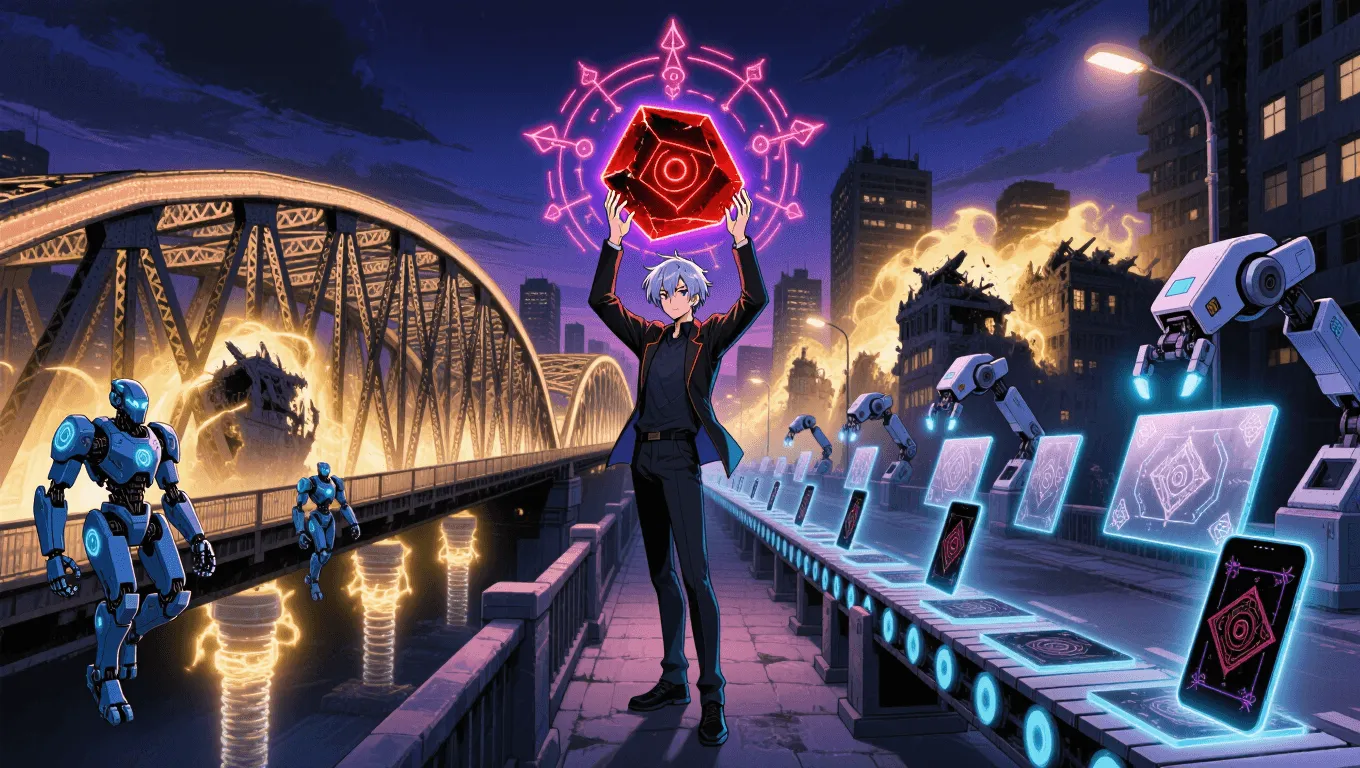Alchemy: The Science of Superpowered Transformation

Alchemy Video Demo 🎬
Table of Contents
Alchemy is a superpower that lets a user transform matter and redirect energy through rules-based transmutation. In most settings, the alchemist studies a target, breaks it into components, and reconstructs it as something new—often with the help of alchemical circles, arrays, and runes. Because alchemy balances creativity with constraints like equivalent exchange, it becomes a flexible toolkit for crafting gear, shaping terrain, brewing elixirs, and solving problems under pressure. This guide explains what alchemy is, how it works, what it can and cannot do, and how it pairs with other abilities. For comparisons across many abilities, browse the complete superpower wiki or roll ideas with the random superpower generator.
What Is Alchemy
In superpowered fiction and tabletop systems, alchemy is controlled material transmutation guided by symbolic logic. The user applies knowledge of chemistry, physics, and ritual design to rearrange atoms and molecules without ordinary tools. Most systems follow three linked steps:
-
Analysis: Determine the composition and structure of the source material.
-
Deconstruction: Reduce the material to a workable state—disassembling bonds or returning it to raw substrates.
-
Reconstruction: Reassemble the components into a new configuration that meets the intended function.
This “study → break → build” loop can be executed with chalk-drawn circles, inscribed arrays on gloves or gauntlets, etched runes on catalysts, or even gesture-based sigils. Some settings allow circle-less casting after years of practice; others require a prepared diagram for safety.
A few worlds introduce legendary catalysts, most famously the philosopher’s stone. Such a stone often stores or channels immense energy, letting an alchemist bypass normal limits on scale, speed, or the cost of complex reactions. Whether or not a campaign allows that device dramatically changes the ceiling of the power.
Core Abilities of Alchemy
Transmutation of Matter
Transmutation is the headliner. The user reshapes wood, stone, glass, metal, clay, and composites into useful forms—barriers, tools, weapons, braces, braces for injured structures, or precision fittings. With practice, the alchemist can tune hardness, density, elasticity, and grain alignment to match a role, such as impact-damping plates for armor or low-friction bearings for machines.
Reactive Element Design
Rather than commanding fire, water, earth, or air directly, an alchemist achieves elemental effects by designing reactions. Examples include igniting oxygen-rich mixes for flame bursts, precipitating clean water by binding impurities, or compacting dust into ceramic tiles. This indirect approach rewards planning and environmental awareness.
Alchemical Circles, Arrays, and Runes
Symbols act as the blueprint and safety net. Circles define boundaries, arrays encode inputs and outputs, and runes apply modifiers—amplifiers for power, baffles for heat, vents for gas, or symmetry locks for stability. Portable arrays on gauntlets accelerate casting; large floor circles enable high-output projects like bridges or bulwarks.
Elixirs, Philters, and Alchemical Items
Alchemy extends into consumables: tonics that speed recovery, antitoxins, night-vision drops, stimulants with controlled crash curves, or stone-skin draughts that harden epidermal layers. Throwables include smoke philters, flash vials, adhesive foams, dissolvers for restraints, de-icers, and cryogel packs.
Catalysts and Energy Routing
Common catalysts (salt, copper, silver, quicklime, rare earths) improve yields, speed up transitions, or protect the user from backflow. In some rules, a catalyst can store surplus energy from earlier reactions to fund a bigger effect later.
Structural and Material Insight
Many alchemists develop a sense for microstructure. By touch or focused observation, they can detect stress lines, voids, impurities, and hidden compartments. This analysis prevents brittle transmutations and helps in sabotage or repair.
Construct Crafting
At higher levels, alchemists fashion constructs: latticework drones, auto-sealing doors, programmable traps with dissolvable safeties, or self-healing materials seeded with reactive microcapsules. In darker stories, homunculus creation exists—but usually with ethical and legal red lines.
Application / Tactical Advantages in Combat
Terrain Control and Fortification
Alchemy shines at changing the map. The user can raise chest-high cover, fuse door frames shut, cut trenches, smooth hazardous rubble for evacuation, or seed the ground with caltrops. Terrain denial creates chokepoints and buys time against stronger enemies.
On-Demand Equipment and Ammunition
Because the alchemist can refactor scrap or rubble, they do not need to carry a full armory. Expect instant grapnels from rebar, ceramic knives that ignore magnets, non-conductive batons for lightning threats, or armor plates tuned to absorb either kinetic or thermal stress. Disposable tools—wedges, clamps, pitons—appear in seconds.
Nonlethal Control
Transmutation supports precise, nonlethal takedowns: cuffs that fuse without locks, adhesive floors that slow pursuers, soft cages from expanding foam, or targeted weakening of a wall panel to separate a single foe without collapsing the room.
Chemical Edge
Prepared items multiply options: smoke to blind sensors, corrosion vials to cut vehicle cables, cryogels to halt engine overheating, or exothermic packs to keep electronics within operating temperatures in blizzards. In team play, these consumables turn close fights.
Sustain, Logistics, and Field Repairs
Few powers rival alchemy for logistics. The user can patch armor plates, reface broken gears, seal hull breaches, print emergency gaskets, and pour quick-setting bridges. This sustain advantage lets squads fight longer and travel farther with less resupply.
Level: Level 1 🏙️, Level 2 🌇, Level 3 🌃
Level 1 🏙️ — Apprentice Transmuter

-
Scope: Small objects within reach; single-material edits; circles required.
-
Feats: Fix a cracked blade, turn rubble into a knee-high barricade, brew simple antitoxin, craft smoke vials, bind a door with fused hinges.
-
Limits: Slow setup; fragile results if composition is unknown; strict equivalent exchange; noticeable fatigue after a handful of casts.
-
Best Use: Support and utility—patching gear, prepping routes, and providing basic crowd control.
Level 2 🌇 — Field Alchemist

-
Scope: Room-scale reshaping; partial circle-less casting via inscribed gloves; mixed materials allowed.
-
Feats: Raise wall segments, lay shock-absorbing flooring, craft modular armor, produce regeneration and stamina tonics with side-effect management, chain reactions (ignite → smoke screen → glass slag).
-
Limits: Precision drops under stress; catalysts needed for heavy lifts; risk of blowback from poor symbol hygiene.
-
Best Use: Skirmish controller—shape engagements, pivot between offense and defense, and maintain equipment for the squad.
Level 3 🌃 — Grand Arcanotechnician

-
Scope: Structure-scale edits; gesture-only arrays; wide-area logistics.
-
Feats: Reface a bridge, build seismic dampers under a district, mass-produce smart materials with embedded runes, assemble autonomous constructs. If the setting permits, wield a philosopher’s stone for city-grade healing or energy substitution.
-
Limits: Massive energy draw; political and ethical scrutiny; catastrophic results if containment fails.
-
Best Use: Strategic reshaping—end sieges by remodeling terrain, neutralize superweapons by converting their fuel, restore disaster zones at speed.
Limitations of Using the Alchemy
Equivalent Exchange and Conservation
Outputs must match inputs in mass and energy, or the user must pay the cost through catalysts or stored energy. Trying to “make something from nothing” courts backlash, from fizzled reactions to personal harm.
Composition Knowledge
Success depends on knowing what something is made of. Unknown alloys, layered composites, and complex organics are easy to ruin. Rushing analysis often yields brittle structures, toxic byproducts, or unstable heat loads.
Symbol Integrity and Geometry
Circles and arrays are sensitive to smudges, bad angles, missing vents, or misaligned runes. Wet weather, blowing dust, and electromagnetic noise increase miscasts. Many alchemists carry stencil kits or etched plates to keep geometry clean.
Energy, Heat, and Fatigue
Even routine transmutations generate heat and draw stamina. Without pacing and venting, the user risks tremors, tunnel vision, or burns. Long operations require cooling channels and scheduled rest.
Ethical and Legal Boundaries
Human transmutation, bioweapon elixirs, and homunculus manufacture are commonly illegal. Licensed practitioners may face audits; unlicensed ones may be banned from purchasing catalysts. Narrative worlds often treat these constraints as real stakes.
Weakness against what other superpowers
Nullification and Anti-Transmutation Fields
Powers that dampen magic or suppress exotic energies can shut down arrays or randomize outcomes, forcing the alchemist to rely on mundane tools.
Super Speed and Instant Mobility
Speedsters and teleporters compress time-to-contact. Because alchemy benefits from a second of setup, blitz attacks can interrupt arrays or bypass newly raised cover.
Electromagnetic Interference and Tech Disruption
EM interference can scramble light-projected circles, overload targeting lenses, or corrupt programmable runes layered into constructs.
Reality Warping and Probability Manipulation
If an opponent can rewrite physics or skew probabilities, the alchemist loses the reliability of rules-based design. Carefully balanced reactions become unreliable.
Intangibility and Phasing
Hard barriers and fused doors mean little to someone who can walk through matter; in those cases, pressure, temperature, and chemical atmospheres become the better tools.
Psionic Disruption
Mind fog, hallucinations, or forced distraction degrade the precise concentration needed for multi-step transmutation, increasing misfire rates.
Synergistic Power Combos
Alchemy + Telekinesis
Telekinesis stabilizes components while the alchemist layers different materials: ceramic cores, metallic shells, and elastic joints can be assembled midair with perfect alignment.
Alchemy + Cryokinesis or Pyrokinesis
Rapid temperature control accelerates or caps reactions. Flash-freezing creates controlled fractures before a rebuild; post-heating anneals newly formed alloys for durability.
Alchemy + Technopathy
A technopath streams diagnostics and CAD-like schematics; the alchemist fabricates parts on the fly. Together they can rewire drones, restore grids, and print adaptive armor in the field.
Alchemy + Biomancy (Ethical Mode)
Safe overlaps enable medical miracles: bio-compatible splints, chelators tuned to a patient’s profile, regenerative gels that coordinate with tissue rather than fighting it.
Alchemy + Illusion
Illusions hide circle drawing, catalyst placement, or the buildup to big plays. The team gets crucial seconds without tipping off observers.
Alchemy + Time Dilation (Localized)
A small time-slow bubble around the array raises precision and yield, letting the alchemist execute complex constructions during combat lulls.
Known Users
-
Doctor Doom (Marvel Comics): A technomystic whose portrayals sometimes blend alchemy, sorcery, and high science—useful as a reference for hybrid arrays, catalysts, and armor integration. Learn more about Doctor Doom.
-
Nicolas Flamel (various modern retellings): Often tied to the philosopher’s stone as a narrative device for longevity, large-scale healing, or unrestricted transmutation.
-
Archetypal “State Alchemists”: Military engineers in many RPGs and anime-inspired worlds, modeling the analysis–deconstruction–reconstruction loop and the political consequences of large-scale material edits.
To dive deeper into related abilities, browse the broader superpower wiki, or spark ideas with the random superpower generator.
